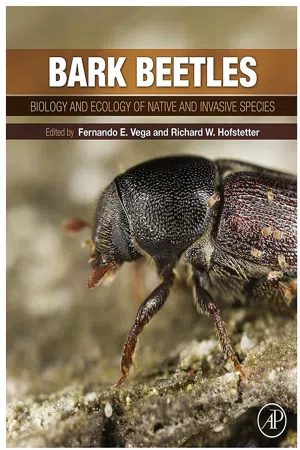
Bark Beetles
Biology and Ecology of Native and Invasive Species
- 640 pages
- English
- ePUB (mobile friendly)
- Available on iOS & Android
Bark Beetles
Biology and Ecology of Native and Invasive Species
About this book
Bark Beetles: Biology and Ecology of Native and Invasive Species provides a thorough discussion of these economically important pests of coniferous and broadleaf trees and their importance in agriculture. It is the first book in the market solely dedicated to this important group of insects, and contains 15 chapters on natural history and ecology, morphology, taxonomy and phylogenetics, evolution and diversity, population dynamics, resistance, symbiotic associations, natural enemies, climate change, management strategies, economics, and politics, with some chapters exclusively devoted to some of the most economically important bark beetle genera, including Dendroctonus, Ips, Tomicus, Hypothenemus, and Scolytus.This text is ideal for entomology and forestry courses, and is aimed at scientists, faculty members, forest managers, practitioners of biological control of insect pests, mycologists interested in bark beetle-fungal associations, and students in the disciplines of entomology, ecology, and forestry.- Provides the only synthesis of the literature on bark beetles- Features chapters exclusively devoted to some of the most economically important bark beetle genera, such as Dendroctonus, Ips, Tomicus, Hypothenemus, and Scolytus- Includes copious color illustrations and photographs that further enhance the content
Frequently asked questions
- Essential is ideal for learners and professionals who enjoy exploring a wide range of subjects. Access the Essential Library with 800,000+ trusted titles and best-sellers across business, personal growth, and the humanities. Includes unlimited reading time and Standard Read Aloud voice.
- Complete: Perfect for advanced learners and researchers needing full, unrestricted access. Unlock 1.4M+ books across hundreds of subjects, including academic and specialized titles. The Complete Plan also includes advanced features like Premium Read Aloud and Research Assistant.
Please note we cannot support devices running on iOS 13 and Android 7 or earlier. Learn more about using the app.
Information
Natural History and Ecology of Bark Beetles
2 Biological Control and Spatial Ecology Laboratory, Université Libre de Bruxelles, Bruxelles, Belgium,
3 Natural Resources and Environmental Studies Institute, University of Northern British Columbia, Prince George, BC, Canada
Abstract
Acknowledgments
1 Introduction
2 Diversity of lifestyles and ecological relationships
Table of contents
- Cover image
- Title page
- Table of Contents
- Copyright
- Dedication
- Contributors
- Preface
- About the Editors
- Chapter 1: Natural History and Ecology of Bark Beetles
- Chapter 2: Morphology, Taxonomy, and Phylogenetics of Bark Beetles
- Chapter 3: Evolution and Diversity of Bark and Ambrosia Beetles
- Chapter 4: Population Dynamics of Bark Beetles
- Chapter 5: Conifer Defense and Resistance to Bark Beetles
- Chapter 6: Symbiotic Associations of Bark Beetles
- Chapter 7: Natural Enemies of Bark Beetles: Predators, Parasitoids, Pathogens, and Nematodes
- Chapter 8: Dendroctonus
- Chapter 9: Biology, Systematics, and Evolution of Ips
- Chapter 10: The Genus Tomicus
- Chapter 11: The Genus Hypothenemus, with Emphasis on H. hampei, the Coffee Berry Borer
- Chapter 12: Scolytus and other Economically Important Bark and Ambrosia Beetles
- Chapter 13: Modeling Bark Beetle Responses to Climate Change
- Chapter 14: Management Strategies for Bark Beetles in Conifer Forests
- Chapter 15: Economics and Politics of Bark Beetles
- Index